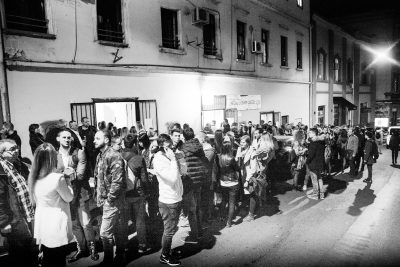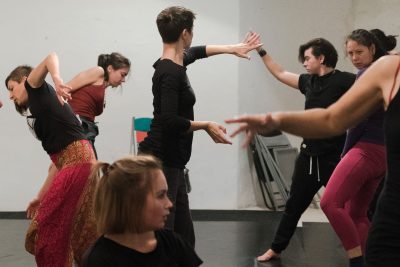In the first application round of our Culture of Solidarity call we received more than 2,500 applications from all corners of Europe and beyond. Out of it, we welcome the first 29 new grantees and their projects into our network! Their imaginative projects range from new international institutes for artists, virtual learning platforms for creatives engaging Black and African communities in Europe to digital handbooks that offer support during COVID-19. Meet them here.
Read MorePress Release: European Cultural Foundation launches the Culture of Solidarity fund
All around the globe we see people reaching out to each other, practicing small and often imaginative human gestures of everyday solidarity, uniting us, across balconies, social networks, cities and countries. It is exactly this culture of solidarity we ought to nourish during this global crisis and beyond. This is why we open a fund to support imaginative cultural initiatives that, in the midst of the global pandemic crisis, reinforce European solidarity and the idea of Europe as a shared public space.
Facing the Coronavirus crisis could be a strong European moment. A moment when people understand how important it is to have friends who support each other, a moment of sharing vital information, expertise and supplies, a moment when you realise how a fundamental crisis can be managed much better through cooperation and solidarity.
But so far this has not been the European moment we had envisioned. National leaders have taken the initiative and do whatever it takes to protect their citizens against the virus. Their approaches might differ in terms of public health responses, but they are surprisingly consistent when it comes to protecting the national interest. Where is Europe and the EU? Where is the shared European interest?
Over the last 75 years, Europe has managed to reinvent itself as a collaborative power, a sharing society. This has served us Europeans well. We cannot afford a rollback. We need to do whatever it takes to keep the sentiment of European cooperation and solidarity intact.
In the past weeks, many emergency funds for the cultural and creative sector have been announced at national, regional or local levels and funding opportunities by the EU for the arts and culture are also underway. But so far public funding in Eastern and Southern Europe has been scarce compared to Western and Northern Europe, and we are yet to see support mechanisms for creative initiatives that strengthen a pan- European culture of solidarity.
This is why we open a fund to support imaginative cultural initiatives that, in the midst of the global pandemic crisis, reinforce European solidarity and the idea of Europe as a shared public space.
https://www.culturalfoundation.eu/culture-of-solidarity
The Culture of Solidarity fund will see various application windows this year, and we will distribute funding equally over all windows. The first round opened April 6, 2020, and has a deadline of Monday, 27 April 2020, 12.00 CET.
You want more information, please contact:
Szilvia Kochanowski, skochanowski@culturafoundation.eu, fund manager or Friso Wiersum, fwiersum@culturalfoundation.eu, project manager communications
Democracy Needs Imagination: Europe Talks
Is it possible to hold a debate across Europe, despite language barriers and national borders? Thousands did as part of Europe Talks, which kicked off in Brussels.
Read MoreDemocracy Needs Imagination: campaigning, voter turn-out and keeping it complex
Our #DemocracyNeedsImagination Action Grants support campaigns that defend the future of an open and democratic Europe and get Europeans to vote. In this overview we present a few of them.
Read MoreThank You: you are the Future of Europe!
A letter to everyone who applied for our Democracy Needs Imagination Action Grants.
Read MoreDemocracy Needs Imagination: Music, Art, European Life
Each week we highlight the work of Democracy Needs Imagination grantees: music, art and European life!
Read MoreDemocracy Needs Imagination: Gaming, going viral, and girl power!
Find out all about the second round of selected projects of our new Action Grants!
Read MoreDemocracy Needs Imagination: Voulez-vous voter avec moi?
Find out all about the first round of selected projects of our new Action Grants!
Read MoreFundAction grantees: Introducing Magacin
Magacin is one of the first-ever grantees of our pilot project FundAction. Magacin is a self-organized common space that operates outside the mainstream public or commercial sectors, accommodates communities and holds great social and cultural value in the city. We spoke to them about their experience and the value of systemic change.
The Magacin space after renovation.
Tell us about the initial idea behind Magacin and how it has developed since then. Where did you find your inspiration and are there any particular examples you followed?
Magacin started off as an idea to provide a working space for the independent cultural scene (druga scena) in Belgrade, since there was nothing available. At the time, in 2007, there was also political will from the City of Belgrade to create a model where the City would take all the (legal) obligations of technically running the space (utilities, cleaning etc.) and independent organisations, selected through an open call, would provide the programme for this unique cultural centre.
This endeavour ended up being a semi-failed attempt in which the youth cultural centre – a City-run institution – managed Magacin. The organisations never got to sign a contract for the use of Magacin, even though they were chosen in the initial call and stayed in the space for a number of years. The situation today hasn’t changed legally for the people using Magacin, but the way the space functions today is much closer to the initial idea of an open, inclusive platform that fosters the values of self-organisation and solidarity.
This became possible for several reasons, one being the threat of eviction by the City, in 2015, when the Association ICSS (Independent Cultural Scene of Serbia) was invited to help in the negotiations. At the time, the open calendar model was proposed, as a way to enable any and all organisations to use the space. After a public debate process it was implemented in practice, since the legal situation is still not resolved.
The model itself was adapted from the model of Pogon cultural centre in Zagreb, which is a public-civil partnership institution. However, in the years since, the model has been developed and adapted to the specific situation of Magacin. Most importantly, since the model was implemented, the number of users and usages has steadily grown, and Magacin is now being used by over 100 different organisations and informal groups with almost ten different calendar entries on a daily basis in seven different spaces.
What are the main obstacles (internal & external) you have encountered while building and running the space?
The main obstacle is the lack of a framework that would support the non-institutional models already at work. This framework could easily be implemented. The “only” issue is the stance the City has towards Magacin. The range goes from ignoring what is now one of the most vibrant cultural centres in Belgrade to trying to evict us. Since the first eviction attempt, which was defended by the big public reaction and a campaign organised by ICSS and implemented by a multitude of users, there was another attempt in late 2016.
The public response to these attempts has been overwhelming and the cultural scene stood by Magacin, which led to the public statement by the City that they will not evict us, but would start a negotiation process. The process is now on hold, as we wait for the first meeting with the new City Secretary for Culture.
Internally, there have been surprisingly few issues, for such a diverse and large group that is self-organised and self-governed. This could possibly be ascribed to the outside threat and the successful action that created more solidarity and readiness to be benevolent and cooperative within the group of users.
Your space is a meeting ground for many diverse organisations and creates encounters for the local community. How can their creative potential influence the cultural policy of the country?
We are not officially recognised as policy makers or stakeholders in that process and our footprint and activities are mainly ignored by the state and city officials and decision makers. Nevertheless, we are trying to be that one elephant that is way too big to be hidden under the carpet. By offering directly available space and facilities, without this usual playing-hard-to-get façade, that is seen as a trademark of any institution in this region, we are trying to undermine some age-old dogmas and thus indirectly bring new cultural policies to the table.
Furthermore, being easily available, we are directly becoming an incubator and a meeting point for many emerging initiatives that are directly affecting cultural policies in their fields.
You want to create a new type of institution based on civic-public partnership, reusing urban space for community purposes. Can you tell us a bit more about your idea and goal, and also your strategy to achieve this? Are you at all afraid to speed up the gentrification process?
The most recent development of Magacin cultural centre happened in some sort of post-apocalyptic cultural environment that emerged after galloping gentrification stormed the area. So for us, it is pointless to be afraid that we might speed it up, as we are rather trying to preserve what can be saved in the aftermath of gentrification.
All the local community bonds that we are building at the moment happened organically as we were not obliged or motivated to produce them at any project or policy level.
In the end, Magacin brought several improvements to the neighbourhood and local community, with some of them even being further reaching. But paradoxically the success of these improvements can be attributed to this non-evangelising, passive approach we established that is usually lacking in the many projects that are aggressively bringing participatory cultural programmes to communities.
How do you work towards systemic change, what is the change you want to see, and how are you planning to achieve it?
The most important and urgent systemic changes are even more commonly available resources and accountability for actions. It is our belief that Magacin is contributing on both of these fronts, since there are so many groups and individuals using the space and it is also available to more and more users each month. The open calendar model is evolving with new types of usage and formats and our goal is to offer the model as a tool that could be used by others in similar or different situations where you need to manage resources that are openly shared by many.
We are continually reflecting on both the day-to-day issues and the overall strategic positioning of Magacin so as to use the fluidity as an instrument to broaden the freedom of this model instead of making it more rigid, which we hope will help to keep the structure running. In the future, we believe it is necessary to push the conversation from one particular space with one activity’s focus to the idea that all public spaces should be publicly available and accountable to the public.
Courageous Citizens 2018: Meet the 31 Research & Development Grantees
Meet the 31 new Research & Development Grantees.
Read MoreRecipients of Culture Policy Program grants 2018 announced
The jury selected 7 out of 158 applications submitted to the Culture Policy Program from 14 Arab countries: Jordan, Algeria, Saudi Arabia, Sudan, Iraq, Morocco, Yemen, Tunisia, Syria, Palestine, Lebanon, Libya, Egypt and Mauritania.
Read MoreThe Village, by #RDGrantee Sytze Schalk
Sytze Schalk, #RDgrantee of the 2017 Idea Camp 'Moving Communities' realised a big part of his project recently: a live 'board game' in the Dutch city of Rotterdam.
Read More





